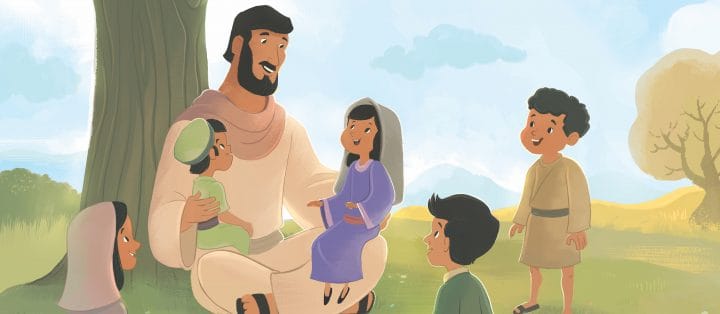An Old Testament Model for Child Discipleship
 We don’t have a great deal of detail about how Old Testament Hebrews conducted the formal, institutional education of their children. In all likelihood, there was little, if any, “formal, institutional education” taking place on a broad scale. This was an agrarian culture where children provided an important “human resource” for advancing the well-being of the family. But this doesn’t mean education wasn’t happening at a significant level throughout the local and national community.
We don’t have a great deal of detail about how Old Testament Hebrews conducted the formal, institutional education of their children. In all likelihood, there was little, if any, “formal, institutional education” taking place on a broad scale. This was an agrarian culture where children provided an important “human resource” for advancing the well-being of the family. But this doesn’t mean education wasn’t happening at a significant level throughout the local and national community.
Education Prescribed
The Torah (the Law given by Moses in the first five books of the Bible) did not prescribe a formal SYSTEM of education the way we think about formal education systems and structures. It did, however, prescribe the religious education of successive generations. Here is one example of this prescription…
Only be on your guard and diligently watch yourselves, so that you don’t forget the things your eyes have seen and so that they don’t slip from your mind as long as you live. Teach them to your children and your grandchildren (Deut. 4:9, emphasis added).
And another example just chapters later…
Imprint these words of mine on your hearts and minds, bind them as a sign on your hands, and let them be a symbol on your foreheads. Teach them to your children, talking about them when you sit in your house and when you walk along the road, when you lie down and when you get up. Write them on the doorposts of your house and on your gates, so that as long as the heavens are above the earth, your days and those of your children may be many in the land the Lord swore to give your fathers (Deut. 11:18-21).
God Himself instructed this fledgling nation to “teach” the story (Deut. 4:9) and “these words of mine” (Deut. 11:18-19) to their children. The fact that Israel survived and maintained a unique cultural and religious identity across the centuries is a testimony to how well they did this, in spite of their persistent sin and rebellion.
Secular and Sacred
We can be fairly certain there was little if any distinction between “religious education” and general education in the mind of an “average” Old Testament Jew. Skills that were essential to living and learning a trade were typically taught within the family. For those who could afford or arrange for more formal schooling (by a local teacher), reading was taught because it was essential to the study of Torah, which included WRITING about the Torah as well as READING the Torah itself.
The ability to read and write by some in the community naturally birthed other writings that covered a broad range of topics that went beyond religious practice and conviction. The strong monotheism found in the Torah and other sacred writings provided a holistic context for all spheres of life. Whatever the educated Jew might have been writing about, it was done so in the context of a world created by “the God of Abraham, Isaac, and Jacob.” For this reason the notion of a “secular” education would be strange and foreign to a faithful, monotheistic Jew.
Practice and Principle
Synagogue Schools (the kind Jesus likely was trained in) probably didn’t arise until during or after the Babylonian Exile as a means of encouraging faithfulness to Torah and to the identity of the community. Prior to this, however, the education of children rested, for most Hebrews, in the hands of the parents and extended family, including the local community where nosey neighbors and leaders often watched children with dutiful interest.
It probably is best that we know only broad strokes about the education of children in the ancient Hebrew world. Times and cultures change. It should be the principles we seek to observe and apply to our own unique context, not the specific practices. It is with this caveat in mind that I would suggest the Old Testament reveals four “broad stroke” elements that characterized how children were educated and raised “in the faith” in the Old Testament world.
Community
The average Hebrew child was raised in the midst of a distinctive community that would influence his or her own identity and way of thinking. Common customs, traditions, commitments, and convictions would be naturally absorbed and adopted by a child from the earliest days of its life. It is hard to overstate the power of this community to shape how a child would think about life. A child will absorb the customs and convictions of its surrounding community rather naturally. This is both good and bad.
For those responsible for a child’s Christian education today, we are challenged by HOW to create an appropriate and biblical community for the child. It is clear in the New Testament that the Israel of the Old Testament now finds expression in the local church. It is the church that represents the Kingdom of God and is, therefore, the community within which a child should find the community of God’s people. The question then becomes how the local church can foster the kind of community where a child can absorb the customs, traditions, commitments, and convictions that will shape a biblical worldview within him or her.
For those of us who wish to produce resources and strategies that foster Christian education in children, we must ask how our resources can encourage and facilitate this kind of community for a child in a local church. This must be one of the things we consider and seek to build-in to our resources.
For those seeking to influence homeschool education, there must be consideration given to how families can be encouraged to engage their children in the life of a biblical church. Separating ourselves from a local church community really isn’t an option if we wish to educate our children biblically. However flawed it may be, the local church provides an important context in which children can grow and learn what it means to be a member of God’s family.
For church-based curriculum (for Bible study classes like Sunday School), we can assume the Bible teaching class typically is taking place in the context of a church community. We cannot and should not assume that parents and families are, by default, always part of that local church community. Resources can, however, recognize this and encourage some level of parental involvement in the child’s Bible education and in the church itself.
The more important factor to be addressed may be how the church’s leadership encourages and fosters a community conducive to a child capturing the needed worldview elements from the church family. How can our resources enable the church’s leadership to do this? It’s not enough to target the volunteer teacher over a class of kids. Any child discipleship strategy must target a church’s senior leadership in order to encourage a comprehensive strategy for creating this kind of community.
Calling
Core to the Hebrew identity was a sense of calling that stretched back to Abraham’s call in Genesis 12:1-3 and even earlier with Adam in Genesis 2:15. The recognition that God had called His people to a unique relationship and purpose is pervasive throughout the Old Testament. This sense of calling is carried in both the stories of the Old Testament and the story of the Old Testament.
The theological term for this calling is “election,” but it is not election in the sense of being chosen for salvation as many today might suggest. In the Old Testament, God’s people were chosen to be in a special covenant relationship with God, but this relationship carried a specific purpose for His people. God called His people to a “blessing” to the other nations.
When God called Abraham in Genesis 12:1-3, He specifically noted that Abraham and his descendants were to be conduits of blessing to “all the peoples on earth.” When God constituted His people through Moses at Sanai, He declared that they were to be a “kingdom of priests” (Ex. 19:6).
This calling wasn’t a concept or bullet point on a list of things the people were to believe. It was part of who they were, even if they often failed to understand its implications. Similarly, children raised in a New Testament church and community should be able to adopt and “absorb” this calling as part of their identity simply by hearing the stories and being around parents and adults who share the calling. This doesn’t mean a sense of calling and purpose shouldn’t be taught deliberately and systematically through the methods available. It does mean, however, that a biblical sense of calling and purpose should be natural part of the community’s identity.
Content
The content of the Old Testament educational “system” was inseparably linked to Israel’s history; its story. Consequently, the content was never purely static or “ancient.” It was dynamic and contemporary because it involved an ongoing story that continued to unfold as the people lived it. It was THEIR history that involved THEIR calling by THEIR God Who had spoken specifically to THEM with unique promises and direction.
Initially, this history was captured in oral traditions (stories) that were passed down from generation to generation when formal education was difficult (during Egyptian slavery, for example). Eventually this history included a written record that was perceived as God’s own Revelation given through Moses in The Torah or the first five books of the Bible (the Pentateuch). In time, the story continued to unfold and was commented on and recorded by prophets, poets, historians, and others. Some of these writings became part of the sacred Scripture (including Torah) that informed and worked alongside the ongoing oral tradition. This story with its objective Revelation (Scripture) formed the core identity of the people (the community) and WAS the content learned and passed on from generation to generation.
When God commanded the wandering Hebrews to teach their children “the things your eyes have seen,” He was referring to their collective and experiential story to date. It was their unique story, HIS story, that God identified as the “scope” of content to be taught. Of the few things we do know about educating children in the Old Testament, we needn’t guess about the prescribed content; it was the biblical STORY!
However we may think about our educational philosophy and strategy, there can be no question that we have a similar responsibility to carry forward God’s unfolding story and teach this content to successive generations. One challenge will involve creating a strategy and structure to communicate the story as a whole and then determining which of the myriad of stories should be taught in the limited time available. This is true in a church, homeschool, or Christian school setting.
Also important in the development of content is the recognition that the Bible is not a collection of random stories that do little more than provide moralistic illustrations for desired behavior. The stories of the Bible become fables when we reduce them to moralistic tales. In fact, the Bible is the objective record of God’s unfolding, ongoing involvement in the lives of people. The biblical story continues to unfold and we (including our children) have a place in that story!
The ongoing, dynamic nature of the divine story (God’s unfolding story) must also challenge us to interpret our calling to be His people in the context of what God continues to do in our world today. The ancient story has not ended. We are to be His people in THIS world. This is not about prescribed behavior for kids, but a perspective that God continues to call us to be a “kingdom of priests” (Ex. 19:6).
Calendar
The Divine Revelation prescribed very specific events (feasts and festivals) that were assigned to specific dates on the calendar. All of these events carried important religious, civic, and cultural significance. All of them were designed to identify and interpret varying aspects of the Israelite story. The Sabbath, for example, was a weekly reminder that the God of their story was the Creator Who ruled all of creation. Creation is where their story began. This simple, weekly observance would burn into a child’s heart the foundational conviction of creational monotheism. Whatever may come, the God they worshiped was the Creator God Who ruled with absolute power even when circumstances may suggest otherwise. Such was the “educational nature” of the Hebrew calendar. I would contend that we have given too little attention to how the calendar can shape our educational strategies.
How, then, do we create a calendar of events, observances, and celebrations that can serve the community’s educational objectives for not just children, but all age groups? And, have we allowed the contemporary church calendar to be hijacked by events and activities that have little to do with the biblical story and very little discipleship value?
Scholars typically recognize seven calendared feasts/festivals prescribed by the Old Testament. Exactly how each of these can be interpreted from a New Testament perspective and then applied to the local church’s calendar remains to be seen and may vary from church to church, tradition to tradition, and publisher to publisher. We would be foolish, however, to dismiss the value and role of the calendar in any child discipleship strategy. And, it might be argued that today’s church should consider adopting new “festivals” within its calendar. How God has worked in the life of a particular congregation may create new opportunities to underscore God’s ongoing work in the child’s local community.
We would also be remiss if we failed to examine how contemporary churches are using the calendar now. Just for the sake of argument, I might ask about the level of attention given to Christmas. I would note that only two of the gospels reference the event at all. The Book of Acts seems to give it little if any attention. This is not to suggest the birth of Jesus is not important to recognize. But even in celebrating the event, we often fail to consider the incarnational significance of Jesus’ birth. Perhaps the Feast of Tabernacles has the power to transform how we celebrate Christmas to recognize the birth and incarnation of Jesus as the ultimate “tabernacling” of our God in the person of Jesus. If approached thoughtfully, we likely will discover that the calendar holds enormous potential for educating and discipling children in our churches.
Conclusion
Recognizing that a comprehensive child discipleship strategy should involve an intentional approach to community, calling, content, and calendar may help move us toward a more effective strategy in the coming decades. Much remains to be considered as we seek to develop practical ways to do this. It makes sense, however, to allow these elements to shape how we think about the future of child discipleship in the 21st century.
Rick Edwards
Author, Speaker, Bible Teacher
See a list of other articles by Rick Edwards.
The above article will provide a model for how the resources we produce and provide on Sunday School Zone will be developed in the future. Our goal is to help the church teach His story to successive generations. We are, therefore, very interested in thinking about and pursuing resources that are biblical in both content and methodology. You can see other articles related to biblical worldview on the site.



